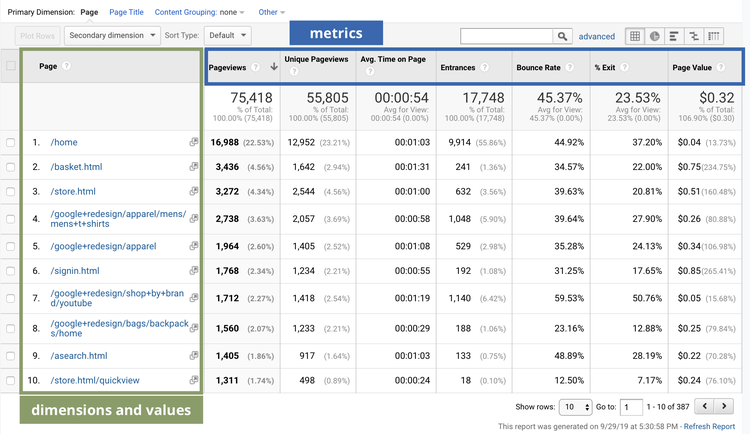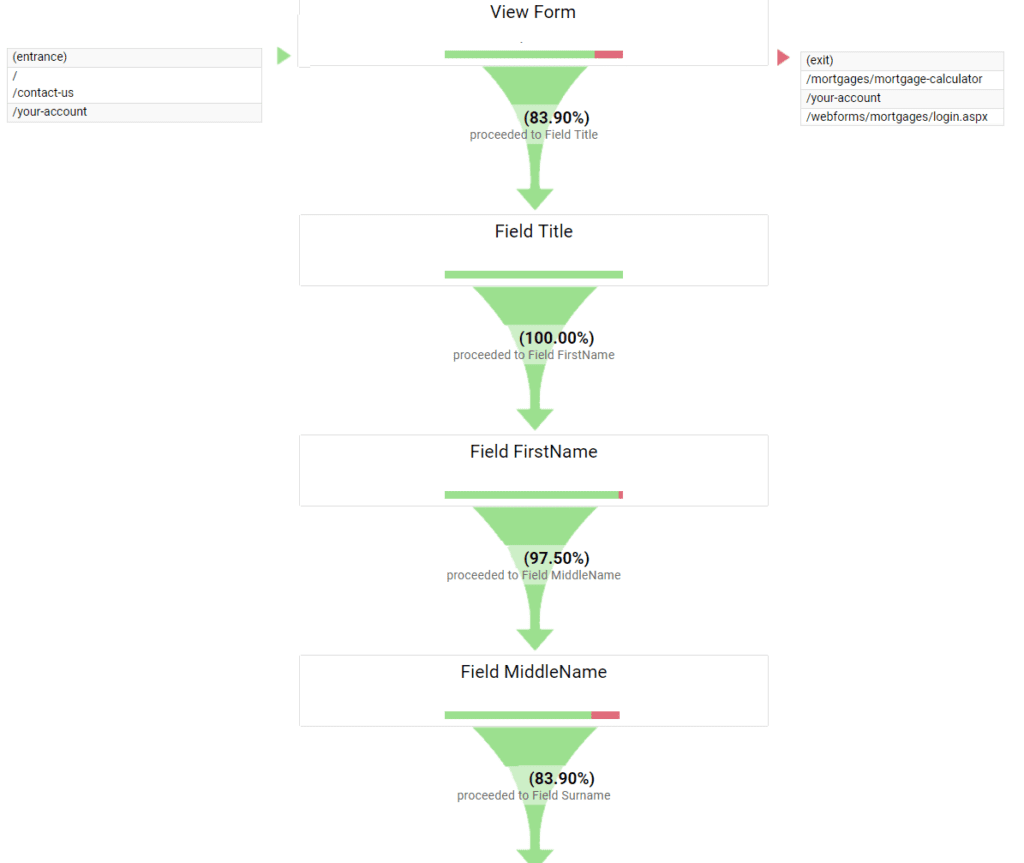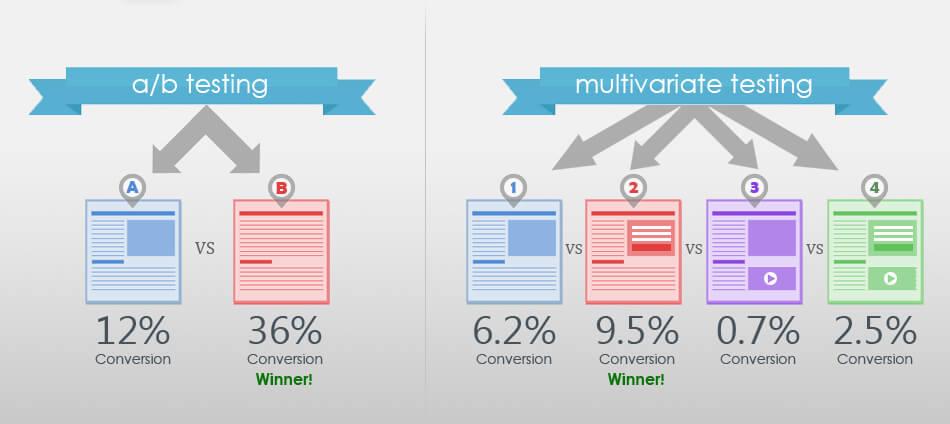A landing page is where your visitors encounter your content after clicking on an advertisement, a listing in the search results, or a link in your email marketing campaign. Naturally, you want to optimize your landing page conversion rate, so you generate the maximum number of leads for your business.
Improving your conversion rate requires you to make tweaks to the copy and design of your landing page. In this article, I’ll discuss how to run multivariate tests on your key landing pages without hurting your business.
How to Test a Landing Page
When testing your landing page, it’s essential to have a structure. You want a system you can follow every time to improve your conversion rate. That structure for a test is like your checklist.
I recommend taking the following approach:
- Review Your Page – Discover how your page is performing.
- Set Your Goal – Set out what you want to achieve. For example, you might want to increase the number of people who sign up to your email list.
- Define Your Hypothesis – How will you achieve your goal. For example, you might decide that making changes to the landing page’s design will improve your conversion rate.
- Choose Your Tools – What tools will you use to gain insights about user behavior and run your tests. You want to use a testing tool that makes it easy for you to track your Key Performance Indicators (KPI).
- Review the Outcome – Decide at what point you will stop running your tests.
The testing methodology I outline above is the same framework scientists use to test theories. You might recognize this approach from your science lessons at school or college.
Landing page testing provides lots of insights into your customer base. You will learn a lot about how they interact with your landing pages and what interests them the most. These are insights you can apply to other elements of your business.
Why Is It Important to Test Your Landing Page?
Landing page and squeeze page conversion rates vary significantly by sector. Some niches have higher landing page conversion rates than others. For example, the average conversion rate for education is 2.01%. Meanwhile, the average conversion rate for automotive is 5.37%. The average conversion rate provides a benchmark for your sector.
More important to your business, though, is the variance within a sector. For example, a top-performing landing page in the business consulting sector can generate more than five times as many leads as an average performing page.
You want one of the best-performing landing pages in your niche.
Improvements to a landing page can directly impact your company’s profits. If you run paid ads to generate leads, a doubling of your conversion rate will reduce your cost per acquisition by 50%.
1. Review Your Page
The first thing you need to do is measure the current conversion rate of your landing page. If you’re using a landing page builder, it probably has an easy to understand feature for measuring your conversion rate. If you’re not using a landing page builder, that’s not a problem.
Several free and paid analytics tools allow you to measure your landing page conversion rates. The most widely used tool is Google Analytics.
Google Analytics gives you detailed insights into where customers are coming from, bounce rates, average session duration, and more. You can set up conversion tracking on Google Analytics to measure your landing page conversion rate. It’s relatively straightforward.

There are plenty of alternatives to Google Analytics. All of the mainstream analytics tools have features that allow you to track conversion rates.
You can use Google Analytics to measure other important metrics. The time on page and bounce rate are two obvious factors. You might also want to review things like the conversion rate by traffic source and potentially pages per session.
Analytics tools like Google Analytics provide you with lots of valuable data. There are other tools you might also want to use. I’ll list the most commonly used options below.
Heatmaps
Heatmaps are a great way to visualize your visitors’ behavior. As the name suggests, heat maps show where the activity is occurring on a page. You can use heatmaps to see where your visitors are clicking on your landing page.

Heatmaps can provide some unexpected insights into user behavior. For example, you can see how a change in where the baby is looking impacts how users interact with the content on that page.
The data you gain from heatmaps will help you come up with hypotheses for your testing. You can use the insights you gain from heatmaps to see where forms should be placed to keep them prominent and where other elements on your page should sit.
Session Recordings
Session recordings are recordings of visitors using your landing page. The recordings capture clicks, taps, movement of the mouse, and scrolling. A session recording can help you experience your landing page from a customer’s point of view. You can see any potential points where they lose interest or identify things that don’t work on the page.
Session recordings provide you with an individual perspective of how a person uses your page. Many people use session recordings and heatmaps together to gain a comprehensive understanding of visitor actions.
Form Analytics
For most businesses, forms are where the conversion occurs. Analyzing how people use a form can help you gain insights into the conversion process. In a long-form, users can get stuck when choosing their country of origin. For example, consider the United Kingdom. It can be referred to as Britain, England, or the United Kingdom.
If your form creates confusion, a visitor might leave your page.
You can use a variety of tools to track form analytics. It’s possible to use the Funnel Visualization Report on Google Analytics, for example, to track your form. It takes a bit of experience to set up this report.

Alternatively, your landing page builder might have the functionality to track form submissions or email signups. Or, you might be using some custom form software that can track submissions and identify problems.

As you can see from those last three data points in the screenshot above, the more fields on your form, the lower the conversion rate. Ideally, you want to reduce the number of input fields as much as possible.
2. Setting Your Goals
In the previous section, I discussed how to gather the data to track your landing page’s performance. Once you have enough data, you need to set your goal. The goals you set for your landing page optimization campaign should be realistic.
I suggest using the SMART framework for setting your business goals. The SMART framework stands for – Specific, Measurable, Achievable, Realistic, and Timely. For example, a SMART goal for your landing page campaign might be, “increase my landing page conversion rate by 100% within 30 days.”
You’ve set a measurable goal. Hopefully, the goal is realistic, and there’s a deadline. That’s a SMART goal.
You don’t need to spend too much time setting your goals. However, you must define what success looks like before you start your campaign.
3. Define Your Hypothesis
Once you’ve set your SMART goals, it’s time to develop a plan of action. You need to set out the types of tests you want to run to increase your conversion rate.
Conversion Rate Optimization (CRO) is an increasingly important area of digital marketing. Like any area of digital marketing, there’s a lot of information you need to understand to become an expert in the field.
You don’t need to be an expert in CRO, though, to run tests. A good hypothesis is based on an understanding of user behavior. Use the data you gathered to put yourself in the shoes of your visitor. Consider what changes you can make to the page to improve the user experience.
Some of the main things you should focus on include:
- Your Incentive – what are you doing to get a person to take action. The better your offer aligns with their goals, the higher the conversion rate.
- Website Copy – the copy you use can have a huge impact on the conversion rate. Review your headline and subheadings. The better you can express why the visitor should take action, the higher your conversion rate.
- Page Layout – is your page easy to navigate, and your conversion goal obvious? For example, putting an ebook image next to your optin form for an eBook helps the reader see what you are offering.
Spend time creating your hypothesis. The more considered the hypothesis, the higher the chance your test will succeed.
Experiment Regret
Experiment regret is when you run a test to improve your landing page conversion rate, and instead of improving your results, the changes you made hurt your business. Unfortunately, you might run into this problem when you run A/B or Multivariate tests on your landing pages.

The best way to minimize the risk of experiment regret is to consider your goals and hypothesis carefully. There are lots of great case studies online where companies share the types of tests they ran and the results of those tests.
Granted, most of those are positive case studies.
Once you’ve decided on the changes you want to test, you need to pick the right tools for the job. I’ll cover that in a bit more depth a little later. First, though, I want to talk about statistics.
Bayesian Versus Frequentist
Two types of statistical models are used for running A/B tests and multivariate tests; there is the Bayesian and the Frequentist approach.
The Bayesian approach to statistics considers the probability of something being correct. It’s a bit like saying, “I think the average height of people in the Netherlands is between 1.84m and 2.20m.” After seeing 200 people, you decide you’re probably right.
You can run tests with the Bayesian statistical model with relatively small sample size and quite fast.
The Frequentist approach to statistics is what pharmaceutical companies use when testing new medicine. You start without making any assumptions and let the data tell the story. As a result, you need a large sample size, and it takes quite a long time to run a test. The degree of confidence in the outcome is much higher than with the Bayesian Model.
To minimize the risk of experiment regret, use a CRO tool that uses the Bayesian Statistical Model.
4. Choose Your Tools
Once you have defined your approach, you need to select the right tools for the job. The best way to run A/B tests or multivariate tests on your landing pages is either with a CRO tool or a landing page builder. Each approach has its benefits and drawbacks.
CRO tools generally offer the most advanced features for A/B and multivariate testing. They are used by marketers with a lot of CRO experience and generally have a higher learning curve. If you have a team to support you, and you want access to a range of CRO tools, I would recommend this approach.
Tools like VWO, Hotjar, and Crazy Egg are great. They have features like screen recording, heatmaps, A/B testing, multivariate testing, and more.
Keep in mind; most CRO solutions can slow your page load time. These tools are designed to change your website’s appearance, so they can also cause unintended bugs. It’s rare, but it does happen, which is why I recommend you have someone you can turn to in case you need any technical support.
The alternative to a CRO toolkit is a landing page builder. Landing page builders are generally easier to use. Most landing page builders have a What You See Is What You Get (WYSIWYG) interface. They are designed to be beginner-friendly and make it easy for you to run tests. There is still a learning curve, but it’s more manageable.
Landing page builders do lack the advanced features of CRO tools. Few landing page builders offer features like heatmaps, for example. However, most landing page builders will integrate with CRO tools, either directly or through GTM. The pages you create are also an add on to your existing CMS.
What Are the Best Elements of a Landing Page to Test?
We’re nearing the end of this blog post. Before I wrap things up, I’d like to leave you with a little checklist of things to test when optimizing your landing page. I’ll also share some mistakes to avoid.
For a successful landing page test, try changing one of these elements below. Test different variations to dig deep into what gets the best response:
- The primary headline
- Headings on the page
- Call to Action text and button
- Images (especially the hero image)
- Videos
- Try different font sizes and styles
- Change the layout/colors
- Change elements of the form – such as position, fields, etc.
When running tests on your landing page, focus on the big things first. The bigger changes are going to have a bigger impact than tiny changes.
When reviewing your landing page, you should avoid:
- Irrelevant content.
- Irrelevant links
- Hard to see images
- Hard to read text (small font, wrong color)
There are many more mistakes that could occur when you’re making a landing page. However, those are some of the major issues to avoid.
Conclusion
In this guide, I discussed how to run tests on key landing pages without hurting your business. If you want to improve your landing page conversion rate, you need to start by reviewing your page’s performance. Define the conversion rate, and use the appropriate tools to see how people interact with your page.
Once you’ve completed a review of your page, set your goals. Next, consider the best way to improve your conversion rate. You might decide the best approach is to change your copy, or you might decide the best way to improve your conversion rate is to make changes to the page’s layout.
Once you’ve decided on your approach, select the tools for the job. You will probably need to choose between a tool with a tool like VWO or similar or a suitable landing page builder. Finally, run your test and review the results—best of luck with your landing page testing.




![Yes, B2B Websites Can Use Personalization Too [Here’s How]](https://mdvirtue.com/wp-content/uploads/2022/02/Yes-B2B-Websites-Can-Use-Personalization-Too-Heres-How-400x250.jpeg)

0 Comments